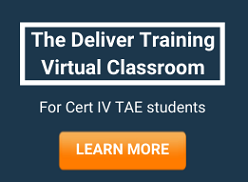About this unit.
This unit specifies the competency required to facilitate learning by individuals within a group.
The full Unit of Competency is available here.
Table of contents:
- Clarify the Purpose of the Learning Program
- Recognition of Prior Learning
- Clarifying Our Intentions
- WHS and Duty of Care
- Communicating for Learning
- Group Harmony
- Adult Learning Styles Influence the Learning Strategy
- Knowledge and Skills-Based Learning
- Learning Cues
- Writing a Session Plan
- Communicating for Learning
- Selecting Delivery Methods
- Engaging Presentation Skills
- Audio Visual Resources
- Facilitating Group Learning
- Reward Learning
- Communicating Verbally and Non-Verbally
- Use Language That Suits The Purpose
- Expect the Unexpected
- Managing Group Dynamics
- Delivery Record Keeping
- Reviewing the Program
This unit includes the following elements and performance criteria.
| Element 1. Establish an environment conducive to group learning |
| 1.1 The learning program and delivery plan are read and interpreted to identify and confirm delivery requirements for the specified session |
| 1.2 Availability of all resource needs is confirmed prior to commencement of session/s |
| 1.3 Outcomes of learner recognition processes are obtained from relevant persons to provide flexible responses to individual learner needs |
| 1.4 The learning program/segment of the learning program is introduced and objectives, expectations and requirements including workplace health and safety (WHS) are discussed, clarified and agreed |
| 1.5 A learning facilitation relationship is established between trainer/facilitator and the group using appropriate oral communication and language skills and interpersonal skills |
| 1.6 Relationships with and between learners are initiated which support inclusivity, acknowledge diversity and enable a positive learning environment |
| Element 2. Deliver and facilitate training sessions |
| 2.1 Interactions with learners are based on the application of learning principles in accordance with learner styles and identified learner characteristics |
| 2.2 Each training session is conducted in accordance with session plans but modified where appropriate to meet the needs of the learners |
| 2.3 All resource requirements for delivery are addressed and the diversity of the group is used as another resource to support learning |
| 2.4 Generic skills relevant to the learning objectives are addressed in delivery |
| 2.5 A range of delivery methods are employed and appropriate technology and equipment are used as training aids to optimise the learner experience |
| 2.6 Opportunities for practice and formative assessment are built into the delivery, where assessment is required |
| Element 3. Demonstrate effective facilitation skills |
| 3.1 Presentation skills are used to ensure the delivery is engaging and relevant |
| 3.2 Group facilitation skills are used to ensure effective participation and group management |
| 3.3 Oral communication and language skills are used to motivate the learner and to transfer knowledge and skills |
| 3.4 Interpersonal skills are used to maintain appropriate relationships and ensure inclusivity |
| 3.5 Observation skills are used to monitor individual and group progress |
| Element 4. Support and monitor learning |
| 4.1 Learner progress is monitored and documented to ensure outcomes are being achieved and the needs of individual learners are being met |
| 4.2 Adjustments are made to the delivery plan to reflect specific needs and circumstances and unanticipated situations |
| 4.3 Learners are encouraged to reflect on personal learning progress |
| 4.4 Group dynamics are managed to ensure effective participation by all learners and to maintain effective relationships |
| 4.5 Inappropriate behaviour is managed using conflict resolution and negotiation skills to ensure learning can take place |
| 4.6 Learner records are maintained, stored and secured in accordance with legal/organisational requirements |
| Element 5. Review and evaluate effectiveness of delivery |
| 5.1 The delivery plan is evaluated to determine its effectiveness as a tool in guiding the learning process and feedback is provided to the writer, as appropriate |
| 5.2 Feedback from learners/management/peers is sought on the quality of delivery, and areas for improvement are identified and documented |
| 5.3 Trainer/facilitator reflects on own performance in training delivery |
| 5.4 Areas of improvement/new ideas to improve the quality of delivery/facilitation and to enhance the learning experience are considered and implemented |









